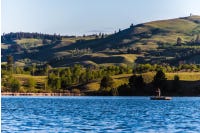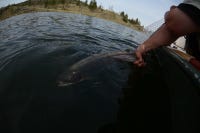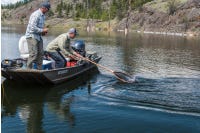DIY Road Trip: British Columbia

Words by Greg Thomas
If you’re planning to fish British Columbia’s southern interior anytime soon you’ll appreciate this piece of advice: get a bigger net.
That’s what I learned one May when I drove from Missoula, Mont., to BC’s Merritt/Kamloops region to meet up with a photographer friend and the noted Canadian fish biologist Brian Chan.
This area has been on my hit list since 1984 when my parents packed my sister and me into a pickup truck and headed from Seattle to Banff National Park for a summer vacation. I thought the trip was all about fishing, but it turned out to be varied and included short hikes, wildlife viewing, and soaking in hot springs. All good with me . . . except during summer when the region’s lakes are ice-free and the fish are eating.
I sulked my way across the province and back, trying my best to ruin the trip for everyone, something that seemed rebellious and cool at the time, but now causes immense regret and forever brands me as the spoiled youngest child. We did catch some trout on that trip, and while fishing from shore one day I watched a 15-pound mackinaw chase a small rainbow into a rock pile at my feet. That event is ingrained in memory, and one of the reasons I decided to retrace tire tracks in May to see what I may have missed three decades ago.
British Columbia’s best inland trout lakes
British Columbia is saturated with lakes. You can’t drive far in any direction and not see an appealing sign promising prime fishing at the end of a dirt road. Some of the most productive and accessible of these lakes lie in the Merritt/Kamloops area northeast of Vancouver, over the mountains and into arid, low-elevation sagebrush and grasslands country. Many of these lakes are shallow, nutrient-rich irrigation impoundments that offer longer growing seasons than those located farther north. That means fish grow fast here and can sometimes be found in big numbers.
According to Chan, there are 800 fishable lakes within an hour radius of Kamloops. One-hundred and twenty of these lakes are stocked by the province. The others offer self-sustaining trout populations. The size of the fish in these lakes depends on management strategies and the amount of pressure each might receive. Suffice, there are multiple dozens of lakes that offer harvest restrictions, bait bans and a single-barbless hook requirement. Focus your eyes on the provincial fishing regulations and you can find a lifetime of intriguing options that match those descriptions. Basically, you could visit the area, which is less than a three-hour drive from Vancouver, just over four hours from Seattle, and just a couple hours from Omak's North 40 store, and jump from one lake to the next over the course of a week, camping or staying in motels or fishing lodges each night. Each day you’d have a fresh opportunity to take some extremely hard-fighting rainbows that range between 10 inches and 10 pounds.


One of the 800 stillwater lake opportunies in the Kamloops area of British Columbia.
Fishing chironomids with Brian Chan
No matter when you choose to fish the area, chironomids will be part of the equation. These seemingly insignificant aquatic insects, which range from a quarter inch to an inch long, make up a majority of a trout’s diet and offer anglers an opportunity to dial in the fish’s behavior and possibly hook scads of these rainbows each day. And if you want to learn how to fish chironomids Chan is the man.
I didn’t go into this trip completely blind. I’d fished chironomids on Washington’s desert lakes and even in Montana on Georgetown Lake, Clark Canyon Reservoir and Duck Lake. But I’d done that while fishing from shore, or in a boat, in shallow water, just 10 yards or so from the bank. When I met up with Chan, he motored us to a shoal on a 50-acre lake he likes and told me to tie 20 feet of tippet to my existing leader. He added, “put a lead weight on your fly and drop it to the bottom.” I didn’t know what to say in response, let alone how I might cast the entire contraption. Chan, sensing my hesitation said, “It’s not pretty.”
The weight, of course, was not to be cast. Instead, I clipped the lead weight to my fly and dropped it overboard. When it hit bottom and my leader went slack, I raised the weight six inches off bottom, pegged a cork to the leader at the water line, and then hand-lined the fly in and removed the lead. This way, Chan explained, I could cast (huck, chuck, whip and duck might be a more accurate description) the fly to a likely spot and let it sit, knowing it would be about six inches off bottom, right where he marked fish on the sonar. A bead head on the chironomid, plus a barrel swivel placed eight inches above the fly, was all the weight needed to reach that depth. Once I’d cast the fly out 10 feet it became a waiting game.
Two nights prior, while fishing out of Corbett Lake Lodge southeast of Merritt, I was overheard telling a couple anglers that I wouldn’t participate in the deep-water chironomid game. “Too slow,” I’d said adding, “I’d probably fall asleep in my pram.” A guy who said he’d fished the lake for something like 46 straight years pulled me aside and said, with authority, “Don’t overlook it. Fishing chironomids is not boring.”
Fair enough. But I didn’t fish chironomids the following day at Corbett. Why would I? There was an excellent late morning Callibaetis mayfly emergence that had the fish slurping below the surface and on top, and with calm conditions I could sight fish for ‘bows that ranged between 17 and 21 inches. For a while the fishing was hit and miss, but around noon the number of rises seemed to quadruple within five minutes. I moved the pram to where I’d just seen five rises and dropped an anchor in six feet of water. Then I tied on a Callibaetis emerger and threw at the first fish passing by. He ate without hesitation. Two hours later I’d landed, perhaps, 20 trout, nothing greater than three pounds, nothing smaller than 16 inches.
Those are typical fish at Corbett, although bigger trout do swim here. These are also standard sizes (although fish to 10 pounds are possible) for the adjacent Douglas Lake Ranch, which offers 12 private lakes ranging between 10 and 65 acres, including the legendary Stoney and Minnie lakes. Corbett and all of the lakes on Douglas are managed as fly-fishing only and offer enough hatches to keep anglers busy for a full week through the entire season, the season basically running from ice-out in March to ice-on sometime in November. You can find these types of lodge offerings throughout south-central British Columbia, making it a dream landscape for DIY and lodge-based anglers alike.


Brian Chan, the "Chironomid King", and the author Greg Thomas.
Brian Chan is . . . the chironomid king
When fishing with Brian Chan you really don’t have an option not to fish chironomids. He is the chironomid king and when I asked him which is his favorite way to fish, he answered with this: “Chironomids, underneath, especially later in the season when the ‘bombers’ come off.” Bombers are inch-long or longer chironomids that emerge later in summer, often in August, that trout really seem to key in on.
Not that these fish shied away from our size 14 and 16 imitations. In fact, it didn’t take long for Chan to reel in a nice fish, about 17 inches long, very well fed, and looking as if its belly were about to explode. But he’d expected better. More action. Back-to-back hookups. Multiple doubles. High-fives all around. And that wasn’t happening. So, before releasing this fish Chan stuck a tube in its throat and withdrew the contents of its stomach. Chan pumped the contents into a small, clear vial, raised it to the sun and said, “That’s not good.”
Inside the vial were tiny creatures called daphnia, a.k.a. water fleas. They were way too small to match with our flies and if all the trout were keyed in on those creatures we were in trouble. Fortunately, some of the trout preferred chironomids and we hooked a fish here or there over the next couple hours. Later, Chan motored the boat around until he found what he wanted to see on the sonar—a pack of large fish in a concentrated area, just off bottom in 23 feet of water. He carefully positioned the boat, dropped bow and stern anchors, and said, “They’re right beneath us.”
I cast my outfit as far as I could (which basically meant I was fishing under the boat) and let the cork bob in the chop. Chan did the same thing, with an identical cork, tippet and fly. Not long after, I was hooked up to a very nice fish, maybe a five-pounder. At Corbett the rainbows were acrobats; here they acted like vampires, avoiding the light and boring deep anytime they got near the surface. I was fishing a fast-action five-weight rod and wishing I were throwing a seven-weight. My right wrist and forearm burned. So how long did I fight this fish? Four minutes? Five minutes? That’s a long time to fight a trout, but I think that guess is accurate—these rainbows were as strong as any I’ve fought, bending the rod to what I thought would be the breakage point and repeatedly diving for bottom just when I thought they might roll over on their sides and slide into the net.
While fighting that fish I’d said, “This is a whale.” Chan corrected me and said, “Actually it’s probably a Blackwater River strain or Pennask Lake strain rainbow.”


A Blackwater strain rainbow
Blackwater strain rainbows and Pennask strain rainbows in British Columbia
Blackwater and Pennask rainbows are stocked in many of British Columbia’s inland lakes and each provide appealing traits. Blackwaters, having developed in a river system with competing fishes, are very aggressive and they can grow to large size, as evidenced at Sheridan Lake near 100 Mile House where these fish average four or five pounds and stretch to 20 pounds. Blackwaters are opportunistic and readily eat aquatic insects and other prey, such as leeches. Pennask rainbows are keyed into aquatic insect hatches making them the favorite target on the fly. And, best, they are prone to jump when hooked up.
When discussing these fish Chan chuckled and said, “There’s another type of fish in these lakes and you’ll know when you hook one.” These fish, he explained, are mistakes from the triploid process which, in layman’s terms, places trout eggs in a pressure chamber at a hatchery facility to produce sexually sterile females that won’t interbreed with native trout stocks, making them ideal for stocking in BC’s interior lakes. Occasionally one of these fish turns out to be a mutant male that produces milt but does not possess a vent to release it. Chan added, “They fight like they are mad, but when you land one they roll over and seem to say, ‘Please, just kill me now.’” I said, “Oh, blue balls. No wonder they want to die.”
Chan works with the Freshwater Fisheries Society of BC, which runs the provincial fish stocking program with a goal to bring more people into fishing, and to sell more fishing licenses. He’s a fish guru and a highly respected angler and possesses a great sense of humor. After I’d hooked several fish in a row—as his flies, which were just a few feet away from mine, went untouched—he said, tongue in cheek, “I don’t get it. We’re using the same flies, same leaders and tippets, and I even soaked our chironomids in the same shrimp oil . . . . I even tried to poach your water and couldn’t get a bite. I’m going to fish the other side of the boat.”
Acting as if he were upset, he swiveled in his chair and cast off the opposite side. And that’s all it took.
For a half-hour or so Chan was into the rainbows like you’d expect the chironomid king to be, missing a strike here, setting the hook securely there, then admiring these beautiful fish before slipping them out of the net and back into the lake. When clouds built to the west and thunder boomed overhead, we reeled in and called it a day.
The following morning I fished with Geoff Moore, a photographer and former representative for the province’s Caribou Chilcotin Coast Tourism Association. We launched his johnboat onto the lake and went to work using the exact tactics Chan taught us the day prior. With a twist. Instead of a chironomid Moore tied on a size-10 olive leech and quickly had a couple takes. And shortly after he had a fish in his net. That’s when I realized that these tactics could be used on any trout lake, whether the fish were feeding on chironomids, scuds, leeches or a mix of all. All you’d have to do is figure out at which depth the trout were feeding and put a fly on their noses.
A couple days later Moore and I were hauling his boat out of the water and calling an end to the trip. We’d caught lots of trout, some that spilled out either side of Moore’s undersized net. And we’d learned tactics we could apply on our homewaters.
During a 10-hour drive home I had plenty of time to consider that family vacation 30 years ago. I’m still not proud of how I acted and fear I’ll pay for it in karma as my daughters hit their teenage years. But there was a reason I acted that way—the stillwater trout fishing in British Columbia’s southern interior is as good as it gets and it’s difficult for me, even as an adult, to pass any of these lakes, or even the roads leading to unseen lakes, without wondering what might be finning in each and wanting to find out, that very moment, for myself.
GEAR SUGGESTIONS
Rods: The Fly Project "Project One" 10' 6wt was designed in Omak, Washington specifically for these lakes - Get The Fly Project Project One 10' 6wt
There are lots of great rods out there but a 10' 5 or 6wt is possibly the most desired among dedicated stillwater anglers. We also carry the Echo Lago which was also specifically designed for fishing lakes... lago being the spanish word for lake.
Reels: You will use the drag so get one that can balance out the longer rod and has a reasonable drag. Any of the reels from Ross, The Waterworks, Abel, Nautilus, or any of the other reputable brands will work well. We like the weight, toughness, and drag on the The Fly Project OC 2
Leaders: This is really going to depend on what type of fishing you are doing and how deep you are fishing. Chances are you will build your own leaders if you really get in to it. If you are looking for a great starting point check out Scientific Anglers Absolute Indicator Stillwater leader.
Tippet: Again this is preference. Nylon tippet is a little more environmentally friendly because it will biodegrade at some point. Fuorocarbon doesn't deteriorate, which is also a benefit in other ways. I don't know if there is an answer to this, but right now we have been curiously fishing Umpqua's Deceiver X Fluorocarbon Pink and I could see that being a useful visual above water while stillwater fishing.
Flies: Here's a large selection of stillwater flies as well as a full selection from Phil Rowley (Brian Chan's protege) and even one of our favorites from Chan himself, Chan's BMW.
Boat: NRS Boundary 85 or 100 (for a solo angler without a power boat/johnboat).





